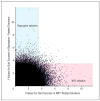Molecular genetics of successful smoking cessation: convergent genome-wide association study results
- PMID: 18519826
- PMCID: PMC2430596
- DOI: 10.1001/archpsyc.65.6.683
Molecular genetics of successful smoking cessation: convergent genome-wide association study results
Abstract
Context: Smoking remains a major public health problem. Twin studies indicate that the ability to quit smoking is substantially heritable, with genetics that overlap modestly with the genetics of vulnerability to dependence on addictive substances.
Objectives: To identify replicated genes that facilitate smokers' abilities to achieve and sustain abstinence from smoking (herein after referred to as quit-success genes) found in more than 2 genome-wide association (GWA) studies of successful vs unsuccessful abstainers, and, secondarily, to nominate genes for selective involvement in smoking cessation success with bupropion hydrochloride vs nicotine replacement therapy (NRT).
Design: The GWA results in subjects from 3 centers, with secondary analyses of NRT vs bupropion responders.
Setting: Outpatient smoking cessation trial participants from 3 centers.
Participants: European American smokers who successfully vs unsuccessfully abstain from smoking with biochemical confirmation in a smoking cessation trial using NRT, bupropion, or placebo (N = 550).
Main outcome measures: Quit-success genes, reproducibly identified by clustered nominally positive single-nucleotide polymorphisms (SNPs) in more than 2 independent samples with significant P values based on Monte Carlo simulation trials. The NRT-selective genes were nominated by clustered SNPs that display much larger t values for NRT vs placebo comparisons. The bupropion-selective genes were nominated by bupropion-selective results.
Results: Variants in quit-success genes are likely to alter cell adhesion, enzymatic, transcriptional, structural, and DNA, RNA, and/or protein-handling functions. Quit-success genes are identified by clustered nominally positive SNPs from more than 2 samples and are unlikely to represent chance observations (Monte Carlo P< .0003). These genes display modest overlap with genes identified in GWA studies of dependence on addictive substances and memory.
Conclusions: These results support polygenic genetics for success in abstaining from smoking, overlap with genetics of substance dependence and memory, and nominate gene variants for selective influences on therapeutic responses to bupropion vs NRT. Molecular genetics should help match the types and/or intensity of antismoking treatments with the smokers most likely to benefit from them.
Figures


References
-
- Mokdad AH, Marks JS, Stroup DF, Gerberding JL. Actual causes of death in the United States, 2000. JAMA. 2004;291(10):1238–1245. - PubMed
-
- Warner KE, Burns DM. Hardening and the hard-core smoker: concepts, evidence, and implications. Nicotine Tob Res. 2003;5(1):37–48. - PubMed
-
- Xian H, Scherrer JF, Madden PA, Lyons MJ, Tsuang M, True WR, Eisen SA. The heritability of failed smoking cessation and nicotine withdrawal in twins who smoked and attempted to quit. Nicotine Tob Res. 2003;5(2):245–254. - PubMed
-
- Karkowski LM, Prescott CA, Kendler KS. Multivariate assessment of factors influencing illicit substance use in twins from female-female pairs. Am J Med Genet. 2000;96(5):665–670. - PubMed
Publication types
MeSH terms
Substances
Grants and funding
LinkOut - more resources
Full Text Sources
Other Literature Sources
Medical
Molecular Biology Databases

